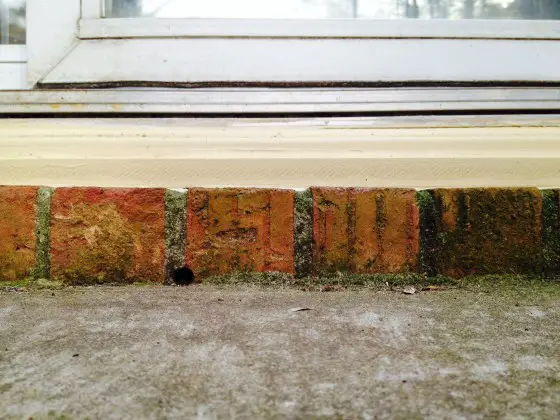Brick Weep Holes

Brick weep holes like the round black hole serves a very important purpose and should never be filled. Copyright 2018 Tim Carter
"Brick walls leak water. They’ve always leaked water. Builders and masons from hundreds of years ago knew this and..."
Brick Weep Holes Tips
- Water gets behind brick walls
- Weep holes allow water to exit the wall
- Mortar can clog weep holes
- Flashings must be installed too
DEAR TIM: I live in a brick townhouse. In the back there is a patio door leading to a concrete deck. The patio door sits on top of some brick work.
We are planning to go from carpet to laminate floors. I'm trying to make sure the patio door is all sealed up keeping out any and all moisture. I've noticed what seem to be round weep holes along the very bottom of the brickwork.
I would like to plug them up with some mortar to keep the moisture level down. Will this do any harm? What purpose do the weep holes serve? Todd J., Newport News, VA
Related Links
Brick Veneer Water Leak Locations
Brick Veneer Sealants - Magic in a Bottle
Never Plug Up Brick Weep Holes!
DEAR TODD: Whatever you do, do not fill those round brick weep holes. They’re an integral part of the drainage system to keep water from building up behind the brick. This water, if allowed to contact any untreated lumber, will cause serious wood rot, mold and eventually structural issues with your home.
Allow me to explain the dynamics of brick walls, brick veneer and rain and you’ll be able to do a fantastic job of protecting that new laminate floor as well as everything else behind the brick.
Do Brick Walls Leak?
Brick walls leak water. They’ve always leaked water. Builders and masons from hundreds of years ago knew this and designed brick buildings using best practices to ensure their buildings did not fall apart.
Sadly, lots of this information for years was handed down by word of mouth. To add insult to injury, not all brick masons of today are not required to learn all the past history about brick construction. If they had a better understanding of what’s going on, they’d be able to do a better job of preventing water infiltration.
Where Does the Water Enter the Brick?
Most water enters brick walls along the interface where the mortar touches the brick. You may not see the ultra-fine line or pathway, but it exists. On row-lock brick like you see under your door threshold the problem is even more severe because the mortar joints are facing the sky. Rainfall has no problems getting into a brick wall at these locations.
Does Wind Force Water Behind Brick Walls?
The pressure of the wind is forcing the water into the brick wall through the cracks like you’d pound a nail into a piece of wood. Each successive rain drop that hits the wall pushes against the water that just hit seconds ago.
This, in combination with the wind pressure, allows water to stream into the wall. This water needs to be captured and redirected so it doesn’t come in contact with any of the wood framing in a brick veneer house.
Why Don't Old Brick Buildings Leak?
Old brick buildings don't leak because they had multiple layers of brick.
Years ago in solid masonry buildings, the masons and builders dealt with this water in a different way. They used harder brick to construct the outer face of the walls but the brick used for the inner second or third course was a softer brick that readily absorbed water.
You can usually spot these brick because they’re an orange color and not a deep earth-tone color.
These soft bricks would absorb the water from the storm and the next day they’d send the water back out to the air via capillary attraction and vapor pressure. As the sun beat on the wall and the breeze blew over it after the storm, the water stored inside the inner brick would come out faster than rats abandoning a sinking ship.
What are Brick Flashings?
A brick flashing is a material that captures water and re-directs it to the exterior of the wall.
In modern brick veneer construction, it’s imperative this water is captured by flashings and waterproof membranes and then redirected to the exterior of the brick wall. One of the components of this system are the round weep holes you see at the bottom of the brick.
There are all sorts of modern products available now that channel the water back to the outside of a brick wall, but it’s impossible to retrofit them into an existing brick veneer wall.
Can Spray Sealants Stop Brick Leaks?
Spray-on sealants can stop some brick leaks. Sealants are not the magic silver bullet, but they may stop much of the water.
Your best bet to protect your home is to apply a clear silane-siloxane water repellent that has enough solids in it to help plug the tiny cracks that allow water to enter at the brick/mortar interface.
What is the Best Way to Apply the Brick Sealer?
The best way to apply a brick sealer is to use a leaf blower.
When spraying these products on a brick wall it really helps to have a helper who’s operating a backpack leaf blower. This person directs the air flow to the area being sprayed with the sealer. The high wind pressure created by the blower forces the water repellent deep into the brick wall to help create a strong barrier against water infiltration.
What are the Best Practices When Building With Brick?
The best practices for building with brick are published by the Brick Industry Association.
If you’re building a new home with brick veneer, then you’ll want to read many of the Technical Notes from the Brick Industry Association. These are easy to understand and have great illustrations. They show all the places where you need very important flashings to collect the water.
Do Flashings Go Under Window and Door Sills?
Flashings must be installed under all window and door sills.
Masons often install brick on edge in these locations and the mortar joints point to the sky. The sad thing is in many of the brick houses I’ve inspected this flashing is missing.
Is it Important to Keep a Water Pathway Open?
It’s also important to make sure the pathway from behind the wall to the front of the weep holes is wide open. All too often mortar falls behind the back of the brick veneer and makes it very hard for water to easily enter the weep holes.
There are products and methods to ensure this doesn’t happen, but many bricklayers and builders don’t use the products and problems happen as the house is subjected to pounding rain. MortarNet® is one product that works to prevent mortar from clogging flashings and weep holes.
Column 1153


2 Responses to Brick Weep Holes